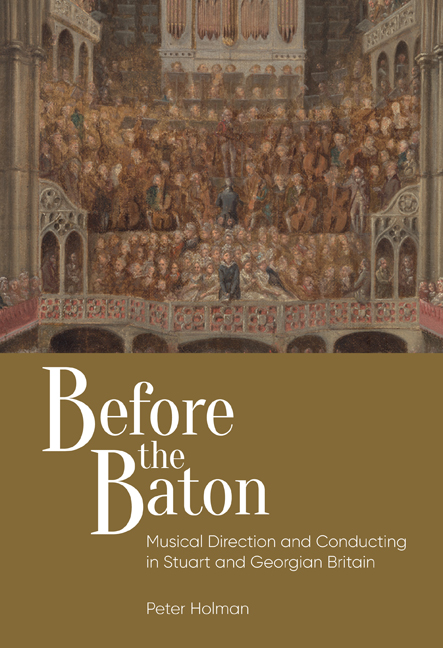Book contents
- Frontmatter
- Dedication
- Contents
- List of Illustrations
- Foreword
- Acknowledgements
- Note to the Reader
- List of Abbreviations
- Prelude To Beat or Not to Beat: The Continental Context
- Part I Directing Choral Music
- Chapter 1 ‘Heard but not Seen’: Leading Anglican Cathedral Music from the Organ
- Chapter 2 ‘With a Scroll of Parchment or Paper, in Hand’: Large- Scale Choral Music
- Chapter 3 ‘Accompanied all along on the Organ by his Own Inimitable Hand’: Handel and the Direction of his Oratorios
- Chapter 4 ‘The Conductor at the Organ’: The Oratorio Tradition after Handel
- Part II Directing Opera and Theatre Music
- Chapter 5 ‘That Ridiculous Custom’: From Devolved Direction to Centralized Time-Beating in Seventeenth-Century Theatre Music
- Chapter 6 ‘Il maestro al cembalo’: Directing Opera and Theatre Music from the Harpsichord
- Chapter 7 ‘A New Discipline and a New Style of Playing’: Directing Opera and Theatre Music from the Violin
- Chapter 8 ‘That Powerful Sovereign, the Conductor’: From the Piano to the Rostrum
- Postlude Superconductors or Semiconductors? Lessons for Today
- Bibliography
- Index
- Miscellaneous Endmatter
Chapter 7 - ‘A New Discipline and a New Style of Playing’: Directing Opera and Theatre Music from the Violin
Published online by Cambridge University Press: 11 September 2020
- Frontmatter
- Dedication
- Contents
- List of Illustrations
- Foreword
- Acknowledgements
- Note to the Reader
- List of Abbreviations
- Prelude To Beat or Not to Beat: The Continental Context
- Part I Directing Choral Music
- Chapter 1 ‘Heard but not Seen’: Leading Anglican Cathedral Music from the Organ
- Chapter 2 ‘With a Scroll of Parchment or Paper, in Hand’: Large- Scale Choral Music
- Chapter 3 ‘Accompanied all along on the Organ by his Own Inimitable Hand’: Handel and the Direction of his Oratorios
- Chapter 4 ‘The Conductor at the Organ’: The Oratorio Tradition after Handel
- Part II Directing Opera and Theatre Music
- Chapter 5 ‘That Ridiculous Custom’: From Devolved Direction to Centralized Time-Beating in Seventeenth-Century Theatre Music
- Chapter 6 ‘Il maestro al cembalo’: Directing Opera and Theatre Music from the Harpsichord
- Chapter 7 ‘A New Discipline and a New Style of Playing’: Directing Opera and Theatre Music from the Violin
- Chapter 8 ‘That Powerful Sovereign, the Conductor’: From the Piano to the Rostrum
- Postlude Superconductors or Semiconductors? Lessons for Today
- Bibliography
- Index
- Miscellaneous Endmatter
Summary
ON Saturday 27 April 1751 Charles Burney went to a memorable and poignant concert at the Little Theatre in the Haymarket; memorable because it was the first public performance in London by the Turinese violinist Felice Giardini (1716–96); poignant because it was almost the farewell appearance of the soprano Francesca Cuzzoni, who had been one of Handel's leading ladies in the 1720s, creating many of his great operatic roles. Cuzzoni was ‘almost deprived of voice, by age and infirmities’, but ‘when Giardini played a solo of Martini of Milan's composition [by G.B. Sammartini], the applause was so loud and long, that I never remember to have heard such hearty and unequivocal marks of approbation at any other musical performance whatever’. Not surprisingly, Giardini quickly established himself at the head of his profession in London, becoming the leader of the opera orchestra at the Haymarket Theatre three years later. According to Burney, Giardini ‘introduced new discipline, and a new style of playing, much superior in itself, and more congenial with the poetry and Music of Italy, than the languid manner of his predecessor [Michael Christian] Festing’. Giardini began a revolution by which the leader supplanted the maestro al cembalo as the effective musical director of London's Italian opera companies – and, following their lead, in London's patent theatres.
❧ Leaders of Italian Opera Orchestras before Giardini
Before discussing what Burney meant by the ‘new discipline’ and the ‘new style of playing’, we should establish the succession of leaders of the opera orchestras in London before Giardini, beginning with Pietro Castrucci. Castrucci was brought to London from Rome by the Earl of Burlington in 1715 with his brother Prospero (also a violinist) and the cellist Filippo Amadei. He was probably already leading the opera orchestra by the 1716–17 season, when he was paid individually for playing in four operas between 15 December and 5 June.
- Type
- Chapter
- Information
- Before the BatonMusical Direction and Conducting in Stuart and Georgian Britain, pp. 253 - 292Publisher: Boydell & BrewerPrint publication year: 2020

